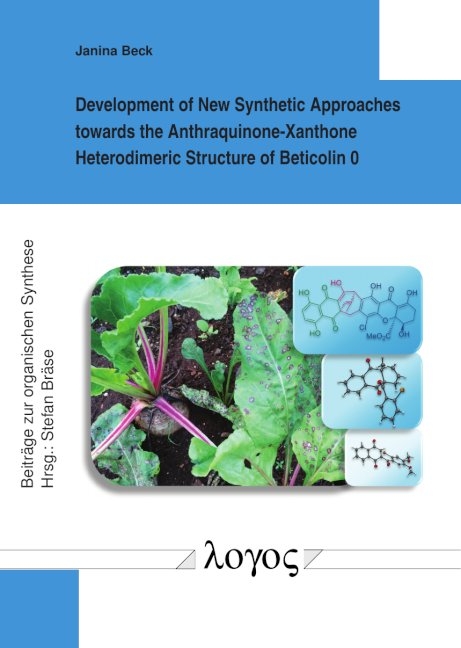
Development of New Synthetic Approaches towards the Anthraquinone-Xanthone Heterodimeric Structure of Beticolin 0
Seiten
2020
Logos Berlin (Verlag)
978-3-8325-5146-9 (ISBN)
Logos Berlin (Verlag)
978-3-8325-5146-9 (ISBN)
Mycotoxins are fungal secondary metabolites exhibiting adverse effects on humans, animals as well as crops, resulting in diseases and economic loss. Beticolins are mycotoxins produced by the fungus Cercospora beticola which is responsible for cercosporiosis, commonly known as leaf spot disease, causing heavy damages to crops worldwide. In order to study the mechanism of action of these biologically active compounds, this thesis aimed at the development of synthetic approaches towards the highly complex polycyclic scaffold of beticolins.
Beticolins consist of a chlorinated tetrahydroxanthone linked to an anthraquinone subunit via a unique bicyclo[3.2.2]nonane ring system. A facile route towards naphthoquinone derivatives and subsequent Diels-Alder cycloadditions with functionalized dienes afforded a highly functionalized anthraquinone subunit of beticolin 0. For the installation of a tetrahydroxanthone subunit, a synthetic route was elaborated. With the obtained anthraquinone derivatives intramolecular couplings were performed under different conditions, to facilitate the construction of the bicyclo[3.2.2]nonane ring system. The formation of the desired scaffold turned out to be challenging, however a variety of novel bicyclo[3.3.1]systems was obtained, representing interesting scaffolds.
During a research stay at the University of Copenhagen, the functionalization of helical β-peptoids was examined. Peptidomimetics adopting three-dimensional structures with well-defined display of functional groups while being resistant to proteolysis, are of interest for the development of foldamers with a desired function.
Beticolins consist of a chlorinated tetrahydroxanthone linked to an anthraquinone subunit via a unique bicyclo[3.2.2]nonane ring system. A facile route towards naphthoquinone derivatives and subsequent Diels-Alder cycloadditions with functionalized dienes afforded a highly functionalized anthraquinone subunit of beticolin 0. For the installation of a tetrahydroxanthone subunit, a synthetic route was elaborated. With the obtained anthraquinone derivatives intramolecular couplings were performed under different conditions, to facilitate the construction of the bicyclo[3.2.2]nonane ring system. The formation of the desired scaffold turned out to be challenging, however a variety of novel bicyclo[3.3.1]systems was obtained, representing interesting scaffolds.
During a research stay at the University of Copenhagen, the functionalization of helical β-peptoids was examined. Peptidomimetics adopting three-dimensional structures with well-defined display of functional groups while being resistant to proteolysis, are of interest for the development of foldamers with a desired function.
| Erscheinungsdatum | 17.09.2020 |
|---|---|
| Reihe/Serie | Beiträge zur organischen Synthese ; 91 |
| Verlagsort | Berlin |
| Sprache | englisch |
| Maße | 145 x 210 mm |
| Einbandart | Paperback |
| Themenwelt | Naturwissenschaften ► Biologie |
| Naturwissenschaften ► Chemie ► Organische Chemie | |
| Schlagworte | anthraquinones • Beticolins • Diels-Alder Reaction • Heck coupling • Natural Product Synthesis |
| ISBN-10 | 3-8325-5146-8 / 3832551468 |
| ISBN-13 | 978-3-8325-5146-9 / 9783832551469 |
| Zustand | Neuware |
| Haben Sie eine Frage zum Produkt? |
Mehr entdecken
aus dem Bereich
aus dem Bereich


